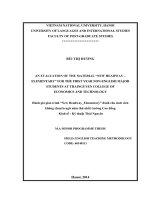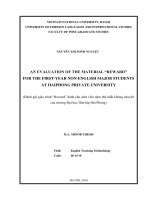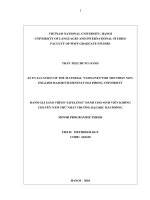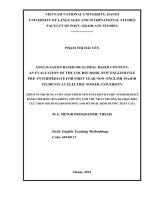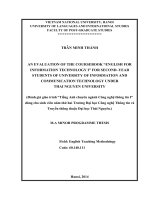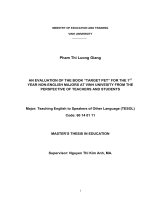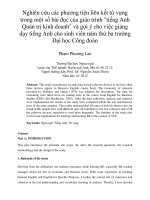AN EVALUATION OF THE ESP MATERIAL ENGLISH FOR INTERNATIONAL TOURISM FOR STUDENTS OF TOURISM DEPARTMENT AT HANOI UNIVERSITY OF INDUSTRY
Bạn đang xem bản rút gọn của tài liệu. Xem và tải ngay bản đầy đủ của tài liệu tại đây (5.99 MB, 75 trang )
VIETNAM NATIONAL UNIVERSITY, HANOI
UNIVERSITY OF LANGUAGES AND INTERNATIONAL STUDIES
FACULTY OF POST-GRADUATE STUDIES
NGUYỄN THỊ THÙY LINH
AN EVALUATION OF THE ESP MATERIAL ENGLISH FOR
INTERNATIONAL TOURISM FOR STUDENTS OF TOURISM
DEPARTMENT AT HANOI UNIVERSITY OF INDUSTRY
ĐÁNH GIÁ TÀI LIỆU TIẾNG ANH CHUYÊN NGÀNH “ENGLISH FOR
INTERNATIONAL TOURISM” DÀNH CHO SINH VIÊN KHOA DU LỊCH
TRƯỜNG ĐẠI HỌC CÔNG NGHIỆP HÀ NỘI
M.A. MINOR THESIS
FIELD: ENGLISH TEACHING METHODOLOGY
CODE: 60 14 01 11
Hanoi, 2015
VIETNAM NATIONAL UNIVERSITY, HANOI
UNIVERSITY OF LANGUAGES AND INTERNATIONAL STUDIES
FACULTY OF POST-GRADUATE STUDIES
NGUYỄN THỊ THÙY LINH
AN EVALUATION OF THE ESP MATERIAL “ENGLISH FOR
INTERNATIONAL TOURISM” FOR STUDENTS OF TOURISM
DEPARTMENT AT HANOI UNIVERSITY OF INDUSTRY
ĐÁNH GIÁ TÀI LIỆU TIẾNG ANH CHUYÊN NGÀNH “ENGLISH FOR
INTERNATIONAL TOURISM” DÀNH CHO SINH VIÊN KHOA DU LỊCH
TRƯỜNG ĐẠI HỌC CÔNG NGHIỆP HÀ NỘI
M.A. MINOR THESIS
FIELD : ENGLISH TEACHING METHODOLOGY
CODE : 60 14 01 11
SUPERVISOR : DR. NGÔ TỰ LẬP
Hanoi, 2015
DECLARATION
I hereby, certify that the minor thesis entitled “An evaluation of the ESP
material ‘English for International Tourism’ for students of Tourism Department
at Hanoi University of Industry” is the result of my own research; and that it has
not been submitted for a higher degree to any other universities or institutions. I
agree that the origin of my paper deposited in the library can be accessible for the
purposes of study and research.
Hanoi, 2015
Nguyễn Thị Thùy Linh
i
ACKNOWLEDGEMENTS
I am, first of all, greatly indebted to my thesis supervisor, Dr. Ngô Tự Lập,
for encouraging me to complete this work. Without his valuable instructions,
comments, criticisms and corrections this thesis would be impossible. Special
thanks go to my lecturers of Post Graduate Department for their useful lectures.
My appreciation and gratitude are also extended to all my colleagues and
students who have stimulated and guided my thinking during the time I did this
research.
Last but not least, I would like to express my deep gratitude to my parents
whose love and encouragement have been equally important to my educational
endeavors, and especially to my husband and my son who has helped me to ease the
burden of the work.
ii
ABSTRACT
Materials evaluation is very important for language teaching and learning
since no textbook or set of materials is perfect. This thesis was carried out to
evaluate the ESP material which is currently in use for the students in Department
of Tourism at HaUI. The research findings are expected to give suggestions for the
adaptation of the material in the near future with an ambition to improve the
effectiveness of the teaching and the learning English at HaUI.
The data collection instruments in this study were questionnaires, interview
and the document analysis. The material in use is analyzed according to the criteria
listed in Hutchinson and Waters’ objective analysis process. A survey on the
teachers' and students' opinions about the extent to which the material meets the
requirements of the course in terms of the aims, content and methodology is
conducted. Finally, the findings from the analyses and the surveys are discussed.
The result of the thesis revealed some strength and weaknesses of the
material. It was found that the material basically met the course objectives in terms
of aims, content and methodology.
Based on the findings, the thesis suggests that adaptation should be made to
overcome its weaknesses so that the students can benefit in the future course.
iii
LIST OF FIGURES AND TABLES
Figure 1: Types of ESP (Kennedy and Bolitho, 1984)
Figure 2: The materials evaluation model proposed by McDonough & Shaw
(1993:75)
Figure 3: The materials evaluation model proposed by Littlejohn (1998:3)
Figure 4: The materials evaluation model proposed by Hutchinson & Waters
(1987:98)
Table 1: The students' opinions on the aims of the material
Table 2: Students' opinions on the difficulty of the material
Table 3: Students' opinions on the usefulness of the material
Table 4: Tourism teachers' opinions on the material
Table 5: English teachers' opinions on methodology
Table 6: Students' opinions on the activities
iv
LIST OF ABBREVIATIONS
ESP: English for Specific Purposes
GE: General English
ELT: English Language Teaching
HaUI: Hanoi University of Industry
EOP: English for Occupational Purposes
EAP: English for Academic Purposes
EST: English for Science and Technology
v
TABLE OF CONTENT
DECLARATION i
ACKNOWLEDGEMENTS ii
ABSTRACT iii
LIST OF FIGURES AND TABLES iv
iv
LIST OF ABBREVIATIONS v
PART A: INTRODUCTION 1
PART B: DEVELOPMENT 4
Chapter 2 begins with the description of the research method. It then specifies
the data collection tools, the subject, and the data collection procedures 18
PART C: CONCLUSION 35
REFERENCES 40
DECLARATION i
ACKNOWLEDGEMENTS ii
ABSTRACT iii
LIST OF FIGURES AND TABLES iv
iv
LIST OF ABBREVIATIONS v
vi
PART A: INTRODUCTION 1
PART B: DEVELOPMENT 4
Chapter 2 begins with the description of the research method. It then specifies
the data collection tools, the subject, and the data collection procedures 18
PART C: CONCLUSION 35
REFERENCES 40
vii
PART A: INTRODUCTION
1. Rationale
Today, English is used in a wide variety of fields such as technology,
medicine, education, science, economics, etc, so it is becoming more and more
important. In Vietnam, English has been taught as a subject in schools and there are
also a large number of English materials being used. In recent years, Vietnam is
applying the student-centered approach in language teaching. As a matter of fact,
curriculum, materials, teaching methods, and evaluation should all be designed for
learners and their needs. As a result, English for Specific Purposes (ESP) materials
relating to different fields become more and more popular.
Materials determine both learning and teaching, so choosing an appropriate
material is very important. However, the more various the ESP materials are, the
more difficult it is to choose an appropriate material for the teaching and learning.
Different materials have different strengths and weaknesses, so evaluation is a
necessary process to help teachers also learners select a good material to follow.
Therefore, evaluation plays as a key role in educational research and development.
As a matter of fact, English materials used to teach the non- English major students
at HaUI have never been evaluated. Although at the beginning of each new school
year, there are always some activities for clarifying aims of the textbooks and the
target results of teaching and learning, many parts in the lessons do not match with
HaUI’s teaching and learning condition. Many students complaint that while they
expect to improve their four English skills - listening, speaking, reading and
writing, English materials used as ESP material for the ESP course of Tourism
department at HaUI “ English for International Tourism” focuses much on speaking
and listening. In addition, the last year students are required to take TOEIC test
(which consists of reading and listening only) and get 450 TOEIC score to graduate
from the university. These concerns arising from the researcher’s teaching
experience, which encourages the researcher to carry out the following research:
“To what extent does the “English for International Tourism (pre-intermediate)”
satisfy the requirements of an English language course at HaUI in terms of aims,
content and methodology?”
2. Practical background of the research
• The English programs of Tourism department at Hanoi University of
Industry (HaUI)
The English courses for the non-major students at HaUI are divided into four
stages: In the first year (the first two semesters), they have to complete 120 forty-
1
five minute periods of general English with the course book “New Headway-
elementary” written by Liz and John Soars. In the second year, they have other 120
forty-five minute periods of general English with “New Headway-pre-
intermediate” written by Liz and John Soars. In the third year, they had 120 forty-
five minute periods with the books “Real listening and speaking 2” and
“Understanding English pronunciation”. For the last year, the students need to
finish 75 forty-five minute periods with the book “English for International
Tourism- Pre Intermediate” written by Dubicka and O’Keeffe (2003).
• The English teaching material
For the last year students of tourism department at HAUI, “English for
International Tourism Pre- Intermediate” written by Dubicka and O’Keeffe (2003)
has been used as the principal material since 2012. It contains 15 units; each unit is
organized by a set pattern of components: language focus, vocabulary, and
professional practice. The first component, language focus, introduces some useful
grammatical structures. In the vocabulary section, a number of words on different
topics are given in reading, listening and speaking tasks. In addition, the students
also have to practice pronunciation with sounds, word stress, ending sounds or
intonation. In the last component, professional practice, the students are offered
opportunities to practice in situations related to tourism.
3. Aims of the study
The main purpose of this study is to evaluate the ESP material “English for
International Tourism Pre- Intermediate” to determine whether it satisfies the
requirements of the ESP course at HaUI in terms of aims, contents and
methodology, which implies what changes to be made to improve the effectiveness
of the material for future use.
4. Research question
To achieve the aims of the study, the answers to the following question were
sought: To what extent does the book “English for International Tourism”
satisfy the requirements of an English language course at HaUI in terms of
aims, contents and methodology?
5. Scope of the study
Evaluating a material relies on a number of criteria such as audience, aims,
content and so on. Given that the target learners and the pedagogical conditions at
HaUI are clearly specified, for this study, the researcher focuses on the following
criteria:
2
- Aims of the book
- Content
- Methodology (in terms of tasks and teaching - learning technique)
Due to the limited scope of a minor thesis, the researcher will invite 60 last
year students to fulfill the survey questionnaires, 7 teachers (4 from the English
department and 3 from the Tourism department) for interviewing. (See more in the
Chapter 2 - Methodology)
6. Methods of the study
The study applies both qualitative and quantitative methods. In order to
achieve the research’s aims, document analysis, questionnaires for the students and
interview to teachers are also exploited.
7. Organization
This thesis includes three parts: Introduction, Development, and Conclusion.
Part A: The introduction provides the rationale, the practical background, the
aims, the research question, the scope, the methods and organization of the thesis.
Part B: The development consists of three chapters:
Chapter one: Literature Review begins with an overview of ESP in language
teaching, and then presents major issues in materials evaluation, including
definition of materials evaluation, reasons for materials evaluation, types of
materials evaluation and approaches to materials evaluation. Research instruments
employed in materials evaluation are also discussed. The chapter ends with a
picture of previous works, both abroad and in Vietnam, on the topic.
Chapter two: Methodology - describes the choice of methodology adopted
in the study, the data collection instruments, the subjects, as well as the data
collection procedures.
Chapter three: Data Analysis and Discussion - discusses the findings of the
study, pointing out the strengths and weaknesses of the material.
Part C: Recommendations and Conclusion - suggests solutions to
improve the material, as well as directions for further research and concludes the
study.
3
PART B: DEVELOPMENT
CHAPTER 1: LITERATURE REVIEW
The first part of this chapter is an overview of the ESP, theories concerning
the evaluation of the ESP material. In the first part, an overview of the ESP course
is introduced. The next part defines materials evaluation and discusses reasons for
materials evaluation, types of materials evaluation, as well as approaches to
materials evaluation. The chapter ends with the review of some previous evaluation
projects.
1.1. An overview of ESP
The growing demand for teaching and learning of English for Specific
Purposes (ESP) often comes from groups of learners who have already completed a
general course and want to learn English for particular reasons connected to their
studies and their jobs. However, there is still confusion between teaching English
for Specific Purposes (ESP) and teaching specialist subjects due to the lack of
understanding what ESP means and what characterizes the ESP. For this reason,
some concepts related to ESP should be made clear before the designing of an ESP
course.
1.1.1. Definitions of ESP
There are various definitions of ESP made by researchers with focuses on the
elements that characterize ESP. Focusing on the primary needs in ESP related to the
learners, the language required and the learning context, Hutchinson & Waters
(1987) see ESP as an approach, but not as a product. While discussing what is
criteria to ESP, Robinson (1991, p.3) points out that an ESP course is based on a
needs analysis, which aims to specify as closely as possible what exactly it is that
students have to do through the medium of English. Actually, learners’ aim of
learning ESP is not only for a general examination but also for their own study. The
learners of ESP usually study to perform a role. In other words, they are considered
to be successful in ESP if they can perform convincingly a role and works well in
their job.
All in all, the authors above agree that ESP can be seen as an approach to
teaching which specifies what the learners need and take the learner’s needs into
consideration. Therefore, in my opinion, an ESP course also should be designed in
such a way that the teachers have to take much concern on the learners’ needs so
that the learners are able to study English purposefully and efficiently.
4
1.1.2. Types of ESP
There are many types of ESP. A major distinction is often drawn between
EOP (English for Occupational Purposes), EAP (English for Academic Purposes),
and EST (English for Science and Technology).
In discussing EOP, Kennedy and Bolitho (1984) point out:
English for Occupational Purposes (EOP) is taught in a situation in which
learners need to use English as a part of their work or profession. Instances
of EOP students would be doctors in casualty or technicians servicing
equipment. They need English in the first case, to talk and respond to
patients and other staff, and in the second, to read technical manuals (p.5).
English for Academic Purposes (EAP) is taught generally within educational
institutions to students in need of English for their studies. The language taught may
be based on particular disciplines at high levels of education when students are
specializing (in - study) or intends to specialize (pre- study) in a particular subject.
For example, an overseas student studying for a high degree at a British University
will need to master language skills such as listening to lectures, taking notes,
writing reports, and reading text books so that these skills will help him understand
the subject matter easily and precisely.
English for Science and Technology (EST) is an important aspect of ESP
program. The term EST presupposes a stock of vocabulary items, grammatical
forms, and functions which are common to the study of Science and Technology.
Below is a classification of ESP quoted by Kennedy from Strevens (1977)
5
To sum up, a large number of various types have painted an overall picture
of the main groups of learners who certainly take much concern of teachers. The
diagram shows the first step for the teachers to analyze and design an ESP course.
1.2. Materials evaluation
1.2.1. Definitions of materials evaluation
Materials evaluation is one of the key components of the process of
curriculum development. So far, a number of definitions of materials evaluation
have been made by different researchers. They all have tried to provide a more
comprehensive and inclusive definition.
Materials evaluation is a process with "attempts to measure the value of
materials" or "the systematic appraisal of the value of materials in relation to their
objectives and to the objectives of the learners using them" (Tomlinson, 1998:3). In
other words, materials evaluation can be considered as a principle process of
providing useful information about the targeted materials in order to select and
develop them in a reliable and valid way.
Material evaluation is a complete process "which begins with determining
what information to gather and ends with bringing about change in current activities
or influencing future one" (Dudley-Evans and St. John, 1998:128).
In general, materials evaluation involves the determination of what needs to
be evaluated, the objectives and requirements of the materials and the judgments of
the value of the materials being evaluated in relation to the objectives and
requirements determined.
1.2.2. Reasons for materials evaluation
There may be various reasons why materials should be carefully evaluated.
According to Cunningsworth (op. cit.), for example, there are two reasons for
evaluation: (1) the intention to adopt new coursebooks; (2) identifying the points of
strengths and weaknesses.
According to Ellis (1997), firstly, there may be a need to select among the
resources available the most suitable materials to use for particular group of
students in a particular context. Secondly, there can be a need to determine whether
the selected or designed material works well to fulfill the intended purposes after
being used for a period of time.
In short, the purposes of materials evaluation are to identify the strengths and
weaknesses of the materials to select or develop the materials. Because materials are
6
considered as a key component of the language-teaching program, it is obviously
necessary that materials be evaluated periodically so that they do not become stale
with the particular program involved. In this research, materials evaluation aims at
pointing out the strength, weaknesses of the materials and also the appropriateness
of using the material in teaching at HaUI.
1.2.3. Types of materials evaluation
Based on the discussion of various scholars, Robinson (1991:59) classifies
materials evaluation into three types: preliminary, summative and formative. The
first two are more likely to focus on published or at least completed materials and
the third focuses on in-house materials.
According to Robinson (1991), preliminary evaluation takes place before an
ESP course begins and involves selecting the most appropriate from the
publications that are available. It is obviously useful in this case to have some sort
of checklist of features which one wants the textbook to have and to rank these in
order of priority.
In contrast to preliminary evaluation, summative (performance evaluation)
takes place at the end of the course and addresses the question of whether the
materials have been effective. Other methods include use of a checklist and use of
questionnaires.
Formative or revision evaluation is conducted while the course is on-going,
so that modification can be made to the materials. Revision evaluation of language
teaching materials has received very little attention in the past, and relatively little is
known about the usefulness of certain techniques. This still seems to be the case.
The main techniques used with performance evaluation are tests and questionnaires,
plus interviews.
Ellis (1997) introduces two new terms related to types of materials
evaluation: predictive and retrospective. Predictive evaluation is design to make a
decision regarding what materials to use while retrospective evaluation examines
the materials that have actually been used.
Recently, Tomlinson (1998:3) has referred to three notions; pre-use, while-
use and post-use when classifying types of materials evaluation. Pre-use evaluation
predicts whether or not materials will work. While-use evaluation examines how
materials really work in the classroom and post-use evaluation aims to find out how
actually effective they are.
7
All in all, although different terms are used to indicate the types of materials
evaluation, they are basically similar. Of these evaluation types, the formative and
summative materials evaluation can only be meaningful determined after a period
of classroom use. In this study, the researcher uses formative or revision evaluation
to evaluate the book “English for International Tourism” while it is on-going at
HaUI.
1.2.4. Approaches to materials evaluation
Because of the importance and necessity of materials evaluation, an urgent
question has been raised: How to evaluate materials systematically and accurately?
So far there have been different approaches of materials evaluation proposed by
different authors. Each one has its own strengths and weaknesses.
1.2.4.1. Cunningsworth’s approach
Cunningsworth (1995) suggested that teaching materials should be
investigated from the following perspectives: language content; selection and
grading of language items, presentation and practice of new language items,
developing language skills and communication abilities; supporting materials; and
motivation and the learners.
According to Cunningsworth, evaluating the material’s language content
means finding out what aspects of language system (form, function, etc), language
skills, and language styles are taught in the material as well as the social context.
Checking the presentation and practice of new language items means finding
out how the new grammatical and lexical items are presented and practiced in the
material as well as the comments on these presentation and practice.
As for developing language skills and communicative abilities, it is
necessary to find out the comments made on the material about the nature of
reading texts or listening material with accompanying exercises or natural of
writing exercises included in the material. Moreover, activities carried out during
the lesson such as activities for free production of spoken English or integrating
language skills must also be taken into account.
1.2.4.2. McDonough and Shaw’s approach
McDonough and Shaw (1993) suggest that materials evaluation can be
carried out in two complementary stages called external and internal stages. The
purpose of the first stage - external evaluation - is “to gain an overview of the
organization principles involved. The evaluating criteria for this first stage are
8
intended audience, proficiency level, language context, presentation of language
items, role and availability of teachers” books, table of content, inclusion of
vocabulary list, use of visuals and presentation, cultural specificity, and so on.
After the first stage, the authors suggest moving on to a detailed internal
evaluation which examines such criteria as: the treatment and presentation of the
skills, sequencing and grading of the materials, types of macro skills (reading,
listening, etc) contained in the materials appropriateness of tests and exercises, self-
study provision, and teacher - learner “balance” in use of the materials.
The purpose of the second stage is to see how far the materials in question
match up to what the author claims and to the aims and objectives of a given
teaching program. Based on the analysis of the claims made on the above criteria by
concerned people like the author, the publisher, teachers, students, sponsors, etc,
teachers’ conclusions regarding the suitability of the materials for specific groups or
individuals can then be reached.
From figure 2, it can be seen that if the external evaluation shows that the
materials are potentially appropriate, the internal stage will be carried out, which is
time-saving. If the external stage show that the materials are inappropriate, it is not
necessary to conduct the next stage. However, when the claims made by the author
are not detailed enough, an internal evaluation also needs to be carried out though
the external stage shows that the materials are not appropriate.
1.2.4.3. Littlejohn’s approach
Littlejohn suggests a preliminary framework for materials analysis and
evaluation as presented in figure 3:
According to this framework, there are four different stages for material
evaluation. The first stage is to analyze the target situation and materials. The target
situation of use is analyzed in terms of the culture context, the institution, the
9
course, the teachers and the learners. The materials are analyzed to describe the
aspects of design and aspects of publication. The next stage is matching and
evaluation which helps the evaluator to figure out how appropriate the aspects of
design and aspects of publication to the target situation of use are. In the action
stage, what can be done to improve the materials such as materials adoption, reject,
adaptation, supplementation, etc. will be carried out.
Analysis of the target situation of use
The culture context
The institution
The course (proposed aims, content,
methodology and means of evaluation)
The teachers
The learners
Materials analysis
From analysis:
* What is their explicit nature?
* What is required of users?
* What is implied by their use?
To description:
Aspects of design
Aspects of publication
Match and evaluation
How appropriate are the aspects of design and
aspects of publication to the target situation of
use?
Action
Adopt the materials
Reject the materials
Adapt the materials
Supplement the materials
Make the materials a critical object
Figure 3: The materials evaluation model proposed by Littlejohn (1998:3)
1.2.4.4. Hutchinson and Waters’s approach
Hutchinson and Waters (1987) divide the evaluation process into four major
steps: Defining criteria; Subjective analysis; Objective analysis; Matching.
In the first step, the criteria for evaluation are determined. In other words, it
is making clear from which perspectives the material will be looked at. Obviously,
different evaluators with different evaluative purposes will need to use different sets
of criteria as discussed in the previous part. Thus, the selection of criteria would
10
focus much on these features so as to make the evaluation more accurate and
pertinent to the given context.
The second step - subjective analysis - is the analysis of the course in terms
of materials requirements under the defined criteria. As suggested by Hutchinson
and Waters (1987) the course can be analyzed in terms of its learners (age, English
level, educational background, interests, etc) and its objectives. Then from the
results the requirements of the material are specified in terms of content and
methodology. With such types of learners and to meet such goals, the material
should follow what kind of language description, cover what language points and
skills, in what proportion, in what sequence, etc. Also from the analysis of the
course’s learners and objectives, the requirements of the material’s methodology are
made clear, for example, the kinds of tasks and exercises needed, kinds of teaching
techniques to be used, aspects of learners’ attitudes to and expectation about
learning to be taken into consideration, etc. In other words, the subjective analysis
brings a detailed description of the ideal material for the learners and the course.
The next step - objective analysis - is the analysis of the materials being
evaluated under the defined criteria. Once again the questions about the target
learners, aims, content and methodology are answered not for the sake of course
analysis but for the sake of the material analysis. (What exactly are there in the
material? What are its actual aims? What are there in its content? What teaching
11
methodology is used in the material). From the answers to these questions, there
comes a detailed description of the material.
In the last step of the process the two analyses are put into comparison to
find out whether they match up to each other and if not, to what extents they do not
match up. Based on the results, good aspects as well as problematic parts of the
material can be identified, which may suggest necessary modifications of the
material to make it as close to the ideal material as possible. Figure 4 can illustrate
the process:
1.2.5. Summary
The four approaches presented above suggest four options to carry out
materials evaluation. Certainly, which model to choose depends upon the
evaluators' purposes.
McDonough and Shaw’s procedure comprises the external and internal
evaluation, which urges evaluators to use their model to select appropriate teaching
materials through the external and internal evaluation. Whereas the external
evaluation provides an overview of the materials organization, the internal
evaluation performs an in-depth investigation in the materials to analyze the extent
to which the materials match the aims of the materials or the objectives of a given
teaching program.
Littlejohn’s approach requires evaluators to both examine different sections
of the materials and move through three different levels of analysis. His model
proposes an open procedure in which the evaluators can investigate the internal
character of the materials and the situation in which they will be used, making their
own personal judgment and act accordingly. Consequently, the model helps
administrators; teachers and learners take more control over the materials.
Hutchinson and Waters (1987) suggest the model for materials evaluation
that is composed of subjective analysis and objective analysis. The most
distinguishing point in the model is the clear-cut description of the stages and
criteria which are presented more systematically than McDonough and Shaw's
working model and more simply than Littlejohn's framework. It can help evaluators
to visualize what must be done to analyze the materials in comparison with the
course requirements. In addition, the guidelines offer a straightforward analytical
matching process to those who are going to do evaluation research. In the ESP
12
teaching and learning context, this model proves to be more appropriate than the
others.
For this reason, the approach of Hutchinson and Waters (1987) will be
applied in this study. However, since the target material was designed for students
of Tourism, its audience is rather clearly defined. The evaluation, therefore, put
more priority on material’s aims, content and methodology.
1.2.6. Criteria for materials evaluation
Evaluation means making judgment, so there must be checklists for
comparative purpose. Checklists for materials evaluation determine which
perspectives of the materials should be taken into consideration. Up to now
different checklists have been developed in order to make the task of evaluating
materials more efficient and accurate. Brown (1995) emphasizes that whether
materials are developed, adapted or adopted, thorough study is very important and
necessary to determine the suitability of the materials for a course. Thus he shows a
very helpful checklist for evaluating textbooks used in a course. The most crucial
criteria listed in the checklist are the fitness of the textbook to the curriculum of the
program including approach, syllabus, general language needs, goal and objectives,
and language content, its logistical characteristics containing price, usability, and
availability, and its teachability including teachers’ editions, review, and
acceptability among learners. The evaluators should begin considering the extent to
which the materials agree with the overall approach and syllabus of the curriculum.
Next, s/he can focus on the degree to which the materials match the language needs
of students in a general way. After that, the specific language needs and situation
needs of the students should be considered. After considering the most important
criteria of the textbook, the evaluator can go on to examining their logistical
characteristic and teachability.
Another checklist for evaluation and selection of course books also given by
Cunningsworth (1995). He suggests examining such aspects provided in the
textbook as language content, topics, skills, methodology. Examination of the
language content should focus on the appropriateness of the main grammar
structures and vocabulary provided in the materials to the students’ needs. As for
examination of skills presented in the materials, there should be answers to the
questions about whether language skills are adequately covered and whether sub-
skills are suitable to the course aims and the students’ level and so on. According to
13
him, the topics of the materials should be interesting, various, able to help expand
students’ awareness and enrich their experience, but not too sophisticated and
unfamiliar within the students’ language level. Except for examination of language
content, skills and topics, questions about methodology of the materials should be
found out whether they are appropriate to the learning and teaching situation of the
program, what techniques, aids are used for presenting new language items, how
different skills and kinds of exercises are taught.
The similar checklist for materials evaluation, which the researcher will
apply to this study, is given by Hutchinson and Waters (1987). These are more
specific and in more detail. According to Hutchinson and Waters (1987) there are
four main criteria for materials evaluation which any evaluator should concern: The
audience, the aims, the content, the methodology.
The audience of the materials (the evaluator should check different
information about learners to find out whether the materials are suitable to the
students’ age, knowledge of English, interest and so on.
Aims of the materials (the evaluator has to check if the materials match the
aims and objectives of the course)
Content of the materials (the evaluator has to check whether the materials’
language points, macro-skills and micro-skills, topics suit the learners’ needs).
Methodology of the materials (the evaluator has to find out if techniques,
aids, guidance provided in the materials satisfy the learners and the teachers of the
course.
1.3. Previous studies
Until now, there have been a certain number of studies carried out by
researchers on evaluating teaching materials, many of them focus on evaluating
ESP materials, such as those by Saeid Najafi Sarem, Hadi Hamidi, Rezvan
Mahmoudie (2013), Vo Thi Anh Dao (2003), Nguyen Thi Bich Lien (2004) and
Tran Thi Thuy Nga (2005).
The most remarkable study on materials evaluation is that of Saeid Najafi
Sarem, JHadi Hamidi, Rezvan Mahmoudie (2013). In this research, the authors use
case study method to evaluate the book “ English for International Tourism Pre
Intermediate” written by Dubicka and O’Keeffe (2003) for pre-intermediate
students majoring in Tourism. The authors based on the evaluation checklist
constructed by Daoud and Celce-Murcia (1979) to evaluate the book. The checklist
14
analyzes and evaluates the book in five sections: subject matter, vocabulary and
structures, exercises, illustrations and physical make-up. Basing on this checklist,
the authors evaluated the book in details with both the pros and cons. The authors
consulted the book with some other qualified teachers of English and piloted some
activities and exercises of the book with some students, at the same level of
language proficiency with that the book has determined, in Sharif Language
Institute in Asadabad, Hamedan as well. The results from the study lead the authors
to the decision of keep using the book for the students of Tourism Department in
Sharif Language Institute in the future. In order to get these results, the authors
worked hard to evaluate the book in every aspects and details. The strength of the
study is that the authors chose a suitable checklist for evaluation. However, the
authors use qualitative descriptive analyses only in evaluating the book; or in other
words, the evaluation of the book primarily bases on the checklist. Although the
authors claim that they consult the book with some teachers and also pilot the
exercises with the students of pre- intermediate level, there is no interview or
questionnaires employed in the study so the results of the study are not very
persuasive and practical.
Vo Thi Anh Dao (2003) chose the criteria proposed by Hutchinson and
Waters to evaluate ESP materials for students of Husbandry and Veterinary Science
at Tay Nguyen University in terms of language level, aims, content and
methodology. The subjects of the study were forty second-year students and four
teachers. The methods used in the study were document analysis, questionnaire for
students and interviews with the teachers. The study was well-presented, evaluated
the suitability of the materials in use to the course aims, content and methodology.
After collecting information from the document analysis and the survey, she
concluded that the materials, when compared with the course requirements, were
difficult for the students in terms of grammatical structures and lexical items.
However, her thesis revealed some weaknesses. Her document analysis was rather
simple. The interview questions seemed to follow the format of a questionnaire.
And it would be much better if she had paid much more attention to examine the
methodology used at the university.
Another study that also based on criteria proposed by Hutchinson and Waters
was carried out by Nguyen Thi Bich Lien (2004). The purpose of the study was to
find out whether the course book Lifelines Pre-intermediate was appropriate to the
15
program and the students' needs in terms of aims, content and methodology. The
subjects of the study were 100 third-year students and seven teachers of Foreign
Languages Department in Hanoi Junior Teachers' Training College. The author
realized that after matching, actions of adopting, rejecting, adapting, supplementing
are important for a complete evaluation process. So a combination model of
Littlejohn and Hutchinson was the most suitable one for her study. The methods
used in the study were document analysis, questionnaire for the students and
interviews with the teachers.
Tran Thi Thuy Nga (2005), in her own thesis, recommended criteria for the
adaptation of the English material for the first and second-year marine students at
NhaTrang navy academy after carrying out document analysis and conducting a
questionnaire survey for teachers and students, using Hutchinson and Waters's
framework for materials evaluation. She concluded that the materials generally
satisfied the requirements of the course. However, the materials still revealed
several weaknesses that need modification. The biggest mismatch of the material in
relation to the course requirements is the inappropriate treatment of the reading
component. A number of reading texts followed by easy comprehension questions
do not help the students to develop their reading skills. The reading tasks do not
offer the students the opportunity to make use of their personal knowledge, ideas
and opinions to tackle the texts. The next mismatch of the material falls into the
treatment of pronunciation elements including sounds, stress and intonation.
The strength of Tran Thi Thuy Nga's study is that her research methodology
helps ensure the reliability of the evaluative results through using document
analysis and questionnaires.
From the above-mentioned studies, it can be concluded that the major
purpose of conducting an evaluation of teaching materials is to evaluate the
effectiveness of the material in use or its suitability to the course aims. It is also
found that the criteria for evaluation may differ to some extent from situation to
situation but generally they can be grouped into the five criteria defined by
Hutchinson and Waters: Audience, Aims, Content, Methodology and Other criteria.
It is also found out that Document analysis, Questionnaire and Interviews seem to
be popular methods to collect the data for materials evaluation.
1.4. Summary
This chapter has dealt with different theoretical issues, which should be
taken into consideration in the work of evaluating ESP materials. The instructional
approaches to materials evaluation are the focus in this chapter. Issues related to
16

